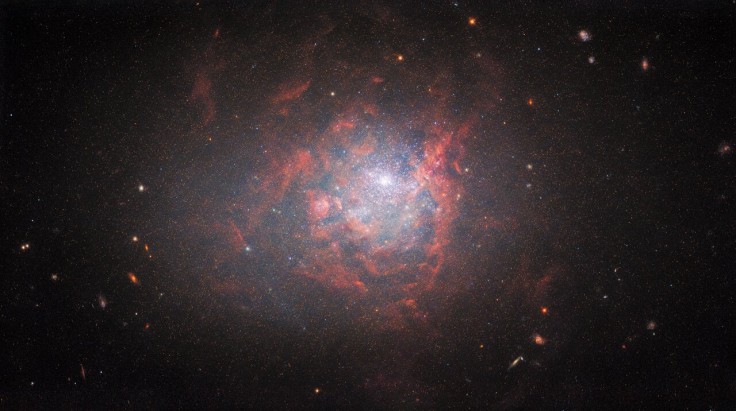The Hubble Space Telescope of NASA has been able to capture an improved image of the dwarf galaxy M87.
The dwarf galaxy NGC 1705 is depicted in this image from the NASA/ESA Hubble Space Telescope.

In the southern constellation Pictor, this little galaxy is approximately 17 million light-years away from Earth and is a member of the Milky Way galaxy group.
Known as a starburst, NGC 1705 is a cosmic oddball because it is small, oddly shaped, and just had a rush of star creation in a short period of time.
Republic World stated that the European Space Agency (ESA) reported that the NGC 1705 has recently entered a "starburst" phase, which indicates that it was experiencing a higher than usual rate of star production.
The dwarf galaxy appears to be encircled by crimson cosmic "clouds" and is illuminated by intense starlight in the illustration.
Galactic Oddball Captured by NASA's Hubble
Aside from its atypical shape, NGC 1705 and other dwarf irregular galaxies of a similar nature can provide useful insights into the overall evolution of galaxies.
Dwarf irregular galaxies are thought to be similar to the early galaxies that inhabited the Universe because they tend to have few elements other than hydrogen and helium.
The NGC 1705 Oddball
Observations of nearby star-forming galaxies were used to gather the data that was used to create this image.
The observations were made to better understand the interaction between stars, star clusters, and ionized gas.
Astronomers hoped to discover millions more emission nebulae by using Hubble's Wide Field Camera 3 to observe a specific wavelength of light known as H-alpha.
According to ESAHubble, emission nebulae are regions formed when bright, young stars bathe the clouds of gas surrounding them in ultraviolet light, causing them to glow.
This is not the first time that NGC 1705 has been photographed by Hubble; in 1999, astronomers used the Wide Field Planetary Camera 2, Hubble's workhorse camera at the time, to peek into the galaxy's heart.
Wide Field Camera 3 (WFC3) replaced this instrument on the fifth and final Space Shuttle mission to Hubble in 2009, and the newer instrument has produced a much more comprehensive and richer portrait of NGC 1705 than the earlier 1999 observation.
Read Also: South African Radio Astronomy Observatory's (SARAO) MeerKAT Telescope Captures Milky Way Filaments
Hubble's Wide Field Camera 3
WFC3 is greatly enhancing the observational capabilities of Hubble.
Compared to its predecessor, it offers improved resolution over a wider field of view. In terms of overall performance, it offers comparable performance to the ACS instrument, but over a wider range of wavelengths.
The combination of these two elements - enhanced field of view and broader waveband - makes for a powerful instrument.
What Is A Dwarf Galaxy?
As stated by ESAHubble, dwarf galaxies, in contrast to their larger cousins, which can contain hundreds of billions of stars, are normally home to only a few billion stars.
A number of dwarf galaxies, such as the Milky Way and the Andromeda Galaxy, are found in the vicinity of larger galaxies.
During the early stages of the formation of these larger galaxies, gravitational forces are assumed to have been responsible for their creation, or as a result of collisions between galaxies, resulting in the formation of streams of material and dark matter ejected from the parent galaxies.
At least 14 dwarf galaxies circle the Milky Way galaxy, which is the most massive galaxy in the universe.
They are assumed to be contemporaneous replicas of some of the distant galaxies found in deep field galaxy surveys, and as such, they can aid us in our understanding of the early phases of galaxy and star formation in the young Uuiverse, which is now under investigation.









